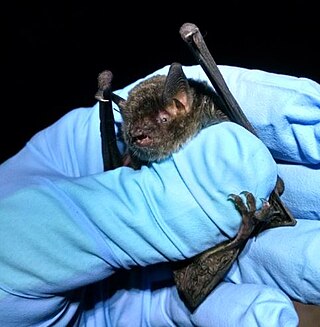
The gray bat is a species of microbat endemic to North America. It once flourished in caves all over the southeastern United States, but due to human disturbance, gray bat populations declined severely during the early and mid portion of the 20th century. 95% of gray bats now hibernate in only 15 caves. M. grisescens has been listed as federally endangered by the U.S. Fish and Wildlife Service since 1976, and is protected under the Endangered Species Act. Gray bat populations were estimated at approximately 2 million bats around the time they were placed on the Endangered Species list. By the early 1980s populations of gray bats dropped to 1.6 million. With conservation efforts in place, in 2004, gray bat populations were estimated to have reached 3.4 million.

The family Mormoopidae contains bats known generally as mustached bats, ghost-faced bats, and naked-backed bats. They are found in the Americas from the Southwestern United States to Southeastern Brazil.

Lundomys molitor, also known as Lund's amphibious rat or the greater marsh rat, is a semiaquatic rat species from southeastern South America.

Lonchophylla is a genus of bats in the family Phyllostomidae.

The western grotto salamander, also called the Ozark blind salamander and previously known as just the grotto salamander, is a species of salamander in the family Plethodontidae. It is endemic to the United States. Its natural habitats are freshwater springs, inland karsts, and caves. It is not currently threatened, but vulnerable to changes in groundwater quality and reduction in bat population.
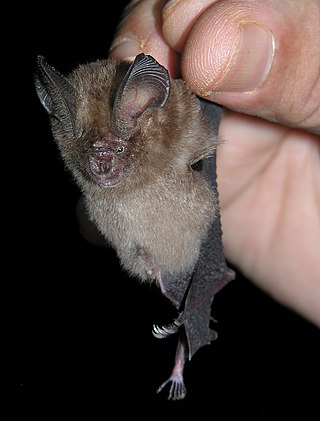
The dusky leaf-nosed bat is a bat from the genus Hipposideros whose habitat extends from India and Sri Lanka to the Philippines, New Guinea and Northern Australia. This species is counted in the H. bicolor species group and was formerly classified within that species.

Leach's single leaf bat, also known as Greater Antillean long-tongued bat, is a species of bat in the family Phyllostomidae. It is found in the southern Bahamas and in all the Greater Antilles. It forms large colonies, with up to a few hundred thousand individuals, and feeds on a relatively wide variety of food items including pollen, nectar, fruit and insects.
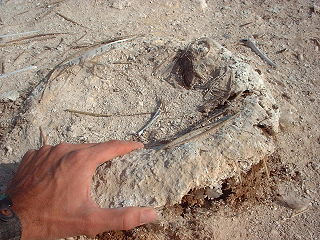
Guano is the accumulated excrement of seabirds or bats. Guano is a highly effective fertilizer due to the high content of nitrogen, phosphate, and potassium, all key nutrients essential for plant growth. Guano was also, to a lesser extent, sought for the production of gunpowder and other explosive materials.

Ornithodoros is a genus in the soft-bodied tick family, Argasidae.
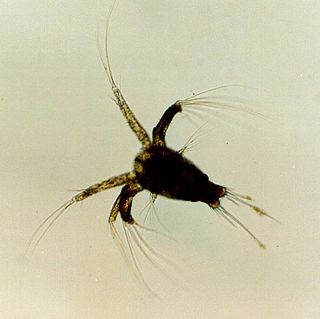
Crustaceans may pass through a number of larval and immature stages between hatching from their eggs and reaching their adult form. Each of the stages is separated by a moult, in which the hard exoskeleton is shed to allow the animal to grow. The larvae of crustaceans often bear little resemblance to the adult, and there are still cases where it is not known what larvae will grow into what adults. This is especially true of crustaceans which live as benthic adults, more-so than where the larvae are planktonic, and thereby easily caught.
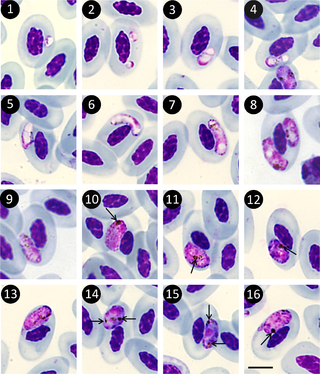
The Haemoproteidae are a family of parasitic alveolates in the phylum Apicomplexa.
Kitum Cave is located in Mount Elgon National Park, Kenya. In the 1980s, two European visitors contracted Marburg virus disease there. It is one of five named “elephant caves” of Mount Elgon where animals, including elephants, “mine” the rock for its sodium-rich salts.

Antricola is a genus of tick containing 16 species. It is very similar to the genus Nothoaspis, which contains the species Nothoaspis reddelli.
Antricola marginatus is a species of tick in the family Argasidae. Like Nothoaspis, another genus in the same family, Antricola species infest cave-dwelling bats; A. marginatus is found on Cuba and Puerto Rico. Unusually for a tick, A. marginatus shows maternal care of its offspring.

Eublaberus distanti, known as the six-spotted, four-spotted, four-spot, or Trinidad bat-cave roach or cockroach, is a primarily cave-dwelling Central and South American cockroach of the genus Eublaberus and named after William Lucas Distant.
Nothoaspis reddelli, also known as Carios reddelli, is a tick that feeds on the ghost-faced bat.
Antricola delacruzi is a species of soft shell ticks in the family Argasidae. Like Nothoaspis, another genus in the same family, Antricola species infest cave-dwelling bats. A. delacruzi exclusively parasites insectivorous cave-dwelling bats of the Pteronotus genus, and are only parasitic in larva form, and are non-parasitic as adults. In both adult and larva form the primary food source appears to be bat guano, although the exact component of the guano that is consumed remains unclear. They are indigenous to the Brazilian rain forest.
Antricola guglielmonei is a species of soft shell tick in the family Argasidae. Like Nothoaspis, another genus in the same family, Antricola species infest cave-dwelling bats. A. guglielmonei is similar to Antricola delacruzi of the same genus and have been found together on bat guano.

Siamophryne is a genus of frog found in Thailand. It is monotypic, consisting of only one species, the Tenasserim cave frog. Its closest relative is the genus Vietnamophryne.













